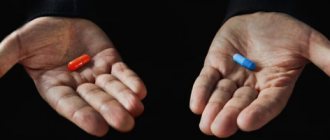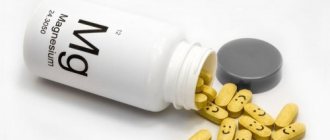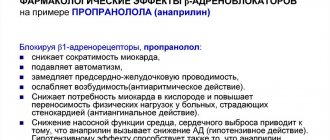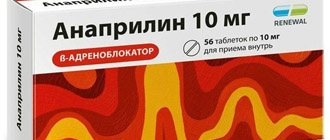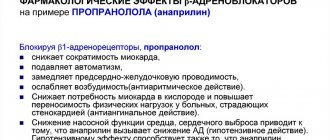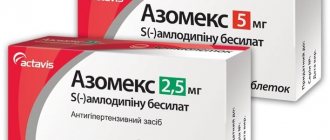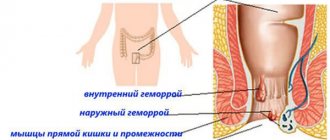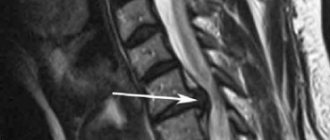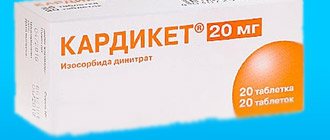Anaprilin is a drug that is often prescribed for hypertension, pathological heart rhythm disturbances, migraines, alcohol withdrawal, anxiety, and panic attacks. The active substance of the drug is propranolol - a selective beta-blocker that normalizes heart rate, lowers blood pressure, reduces tremor, and has a moderate sedative effect. Anaprilin and alcohol are prohibited for joint use due to a decrease in the effectiveness of treatment, as well as the risk of side effects and complications.
Dosage forms of the drug
The medication is intended for oral administration and parenteral administration. Anaprilin is produced:
- In the form of white tablets: with a concentration of 10 and 40 mg of the active substance. Auxiliary and formative components of pills: talc, hypromellose, starch, MCC, silicon dioxide, calcium stearate. The packaging of the drug contains from 10 to 10 pieces, packaged in blisters.
- In the form of a water-based injection solution. A transparent liquid with a concentration of 0.1% is packaged in glass ampoules of 1 and 5 ml, packed in cardboard packs of 10 or 100 pcs. The drug with 25% of the active substance is available in a dosage of 1 ml. One package contains 10 ampoules.
The active ingredient of Anaprilin is propranolol hydrochloride. This compound has a pronounced hypotensive effect, dilates blood vessels, and prevents heart rhythm disturbances. Included in drugs for the treatment of angina attacks and other cardiac pathologies.
Instructions for use ANAPRILIN-ZDOROVYE
In patients with diabetes mellitus, caution should be exercised when prescribing propranolol and hypoglycemic agents simultaneously, as propranolol may prolong the hypoglycemic response to insulin and change heart rate.
Class I antiarrhythmic drugs and amiodarone may potentiate the effect of propranolol on atrial conduction time and cause a negative inotropic effect. Propranolol is used with extreme caution in patients receiving concomitant treatment with cardiodepressants (chloroform, ether or related anesthetics), antiarrhythmic drugs (quinidine, lidocaine, procainamide), which may potentiate the depressive effects of propranolol.
Digitalis glycosides, when used concomitantly with beta-blockers, may increase atrioventricular conduction time.
Antihypertensive drugs potentiate the antihypertensive effect of propranolol.
The simultaneous use of propranolol with calcium channel blockers with negative inotropic action (veralamil, diltiazem) may lead to increased negative inotropic action in patients with impaired cardiac function and/or impairment of sinoatrial or atrioventricular conduction, leading to the development of severe hypotension. bradycardia and heart failure. A β-blocker or calcium channel blocker should not be administered intravenously within 48 hours after stopping the other. Concomitant use of dihydropyridine calcium channel blockers (eg, nifedipine) may increase the risk of hypotension and cause heart failure in patients with latent hypotension. The hypotensive effect of propranolol is enhanced when combined with diuretics (hydrochlorothiazide).
Concomitant use of epinephrine, isoproterenol and dobutamine may reduce or block the effects of propranolol. Caution should be exercised when administering drugs containing epinephrine parenterally to patients using propranolol. as this may lead to vasoconstriction, hypertension and bradycardia. Caution should also be exercised when used with drugs such as isoprenaline and norepinephrine.
Propranolol may exacerbate the "withdrawal" hypertension caused by clonidine withdrawal. If these two drugs are used concomitantly, the β-blocker should be discontinued several days before stopping clonidine. When replacing clonidine with a β-blocker, use of the latter should begin several days after stopping clonidine. Reserpine, when used simultaneously with propranolol, can reduce the activity of the sympathetic nervous system, which leads to hypotension, bradycardia, dizziness, fainting, and orthostatic hypotension.
The use of propranolol during a lidocaine infusion may increase lidocaine plasma concentrations by approximately 30%. Patients who have already used propranolol have a greater tendency to have higher lidocaine blood concentrations than those who have not used propranolol.
When using propranolol concomitantly with ergotamine, dihydroergotamine or related drugs, caution should be exercised due to the possibility of vasospastic reactions.
When used concomitantly, prostaglandin synthesis inhibitors (eg, ibuprofen and indomethacin) may reduce the hypotensive effect of propranolol.
The administration of propranolol, like other beta-blockers, together with an anesthetic may result in attenuation of reflex tachycardia and increase the risk of hypotension. The anesthesiologist should be informed about the patient's use of propranolol and the drug with the least negative inotropic effect should be selected as an anesthetic agent.
Propranolol, tricyclic antidepressants and MAO inhibitors mutually potentiate each other's hypotensive effects. With the simultaneous use of propranolol with haloperidol, the development of hypotension and heart failure is possible, with chlorpromazine - an increase in the concentrations of both drugs in the blood plasma, resulting in an increase in the antipsychotic effect of chlorpromazine and the antihypertensive effect of propranolol. Propranolol increases blood concentrations of imipramine.
The simultaneous administration of propranolol with drugs that are metabolized with the participation of cytochrome P450 isoenzymes CYPD6, CYP2C19, CYP1A2 may lead to changes in the effectiveness and tolerability of propranolol. The metabolism of propranolol in the liver increases with a decrease in its level in the blood when used simultaneously with inducers of these enzymes - barbiturates, rifampicin, phenytoin, ethanol; decreases with increasing levels of propranolol in the blood when used simultaneously with enzyme inhibitors - amiodarone, cimetidine, serotonin reuptake inhibitors (fluoxetine, naroxetine, fluvoxamine), quinidine, ritonavir, imipramine. ciprofloxacin, isoniazid, theophylline, zolmitriptan. No interaction of propranolol with ranitidine and lansoprazole has been established.
Allergens used for immunotherapy or allergen extracts for skin testing, when used concomitantly with propranolol, increase the risk of severe systemic allergic reactions or anaphylaxis. Iodine-containing radiocontrast agents, when administered intravenously during propranolol therapy, increase the risk of developing anaphylactic reactions.
Mechanism of action of Anaprilin
Propranolol reduces the frequency and increases the strength of myocardial contractions. The product works systemically: at the same time it reduces the need for oxygen in the muscular system and improves its tone. As a result, contraction of the walls of the uterus, bronchi, and gastrointestinal tract increases. Anaprilin causes a persistent decrease in systolic and diastolic pressure, prevents the development of a hypertensive crisis, and alleviates the condition during angina attacks. The effectiveness of the medicine is equally high in any position of the patient’s body. The drug reduces the risk of sudden myocardial infarction and allows you to reduce the intake of nitroglycerin. With regular use, Anaprilin helps improve physical performance.
For what diseases is Anaprilin indicated?
The drug is prescribed in the following cases:
- for chronic hypertension;
- coronary heart disease, angina pectoris;
- renal hypertension;
- arrhythmias provoked by rheumatic lesions of the heart muscle: sinus, parochymal, atrial fibrillation, extrasystole;
- as part of rehabilitation therapy: for myocardial infarction, intoxication with digitalis and other medications that disrupt the heart rhythm;
- in the complex treatment of thyrotoxicosis;
- with open-angle glaucoma;
- with essential tremor;
- for the prevention of migraines and cerebrovascular accidents.
With the exception of cases of poisoning with potent drugs, Anaprilin is recommended to be taken regularly. The therapeutic effect is achieved after the first dose and increases over time. By the end of the second week, a persistent hypotensive effect is observed.
Anaprilin
Beta blockers should not be used in patients with untreated chronic heart failure until the condition has been stabilized.
Before using the drug, patients with heart failure (early stages) must use cardiac glycosides and/or diuretics.
Monitoring of patients taking the drug should include monitoring heart rate and blood pressure (daily at the beginning of treatment, then once every 3-4 months), recording an electrocardiogram.
In elderly patients, it is recommended to monitor renal function (once every 4-5 months).
In case of increasing bradycardia (less than 60 beats/min), arterial hypotension (systolic blood pressure less than 100 mm Hg), atrioventricular block, bronchospasm, ventricular arrhythmias, severe liver and/or kidney dysfunction in elderly patients, it is necessary reduce the dose of the drug or stop treatment.
The drug should be used with caution in patients with first degree atrioventricular block.
The patient should be trained in the method of calculating heart rate and instructed about the need for medical consultation if the heart rate is less than 60 beats/min.
It is recommended to discontinue therapy if depression caused by taking beta-blockers develops.
Patients who use contact lenses should take into account that during treatment with beta-blockers, there may be a decrease in the production of tear fluid.
Treatment of coronary heart disease and persistent arterial hypertension should be long-term - taking the drug is possible for several years.
Discontinuation of treatment is carried out gradually, under the supervision of a physician: abrupt withdrawal can dramatically increase myocardial ischemia, anginal syndrome, and worsen exercise tolerance. Cancellation is carried out gradually, reducing the dose by 25% every 3-4 days for 2 weeks or more.
When deciding on the use of the drug Anaprilin in patients with psoriasis, one should carefully weigh the expected benefits and the possible risk of exacerbation of psoriasis.
In thyrotoxicosis, propranolol may mask certain clinical signs of thyroid hyperfunction (for example, tachycardia). Abrupt withdrawal in patients with hyperthyroidism is contraindicated as it can worsen symptoms.
Isolated reports of myasthenia gravis have been reported during propranolol therapy. If muscle weakness occurs, consult a doctor. In patients with diabetes mellitus, the drug is used under the control of blood glucose concentration (once every 4-5 months). Use with caution simultaneously with hypoglycemic agents, since hypoglycemia may develop during prolonged breaks in food intake, as well as during insulin therapy. Moreover, its symptoms such as tachycardia or tremor will be masked due to the action of the drug. The patient should be instructed that the main symptom of hypoglycemia during treatment with the drug is increased sweating. There is also a risk of hyperglycemia when taking oral hypoglycemic agents.
When taking clonidine concomitantly, it can be discontinued only a few days after propranolol is discontinued.
For pheochromocytoma, it is used only in combination with alpha-blockers. Do not use simultaneously with antipsychotic drugs (neuroleptics) and tranquilizers.
Beta blockers may increase sensitivity to allergens and the severity of anaphylactic reactions. Propranolol may cause severe reactions to a number of allergens when administered to patients with a history of severe anaphylactic reactions to these allergens. These patients may not respond to the usual doses of epinephrine (adrenaline) used to treat anaphylactic shock.
Drugs that reduce catecholamine reserves (for example, reserpine) may enhance the effect of beta-blockers, so patients taking combinations of drugs should be under constant medical supervision to detect arterial hypotension and bradycardia.
During treatment with propranolol, intravenous administration of verapamil and diltiazem should be avoided.
Use with caution in combination with psychotropic drugs, for example, MAO inhibitors, when used for a course of more than 2 weeks.
A few days before general anesthesia with chloroform or ether, it is necessary to stop taking the drug (increased risk of depression of myocardial function and the development of arterial hypotension). It is necessary to warn the anesthesiologist that the patient is taking propranolol.
In smokers, the effectiveness of beta-blockers is lower.
The drug should be discontinued before testing the content of catecholamines, normetanephrine and vanillinmandelic acid in the blood and urine; antinuclear antibody titers.
Therapy with the drug should be suspended if there is a respiratory infection of the lower respiratory tract accompanied by difficulty breathing. The use of beta2-agonists and inhaled glucocorticosteroids is allowed. Resumption of use of the drug is possible only after the patient has completely recovered. In case of repeated infection, as well as in the case of isolated bronchospasm, the use of the drug should be stopped completely.
It is not recommended to drink alcohol during treatment (a sharp decrease in blood pressure is possible). Beta-blockers should be used with caution in patients with peripheral circulatory disorders, as these symptoms may worsen.
Avoid using natural licorice during treatment; Protein-rich foods can increase bioavailability.
Propranolol may give a positive result in a doping test.
How to use Anaprilin: instructions
The treatment regimen depends on age, physical condition, type and severity of the disease. General recommendations:
- Swallow the tablets without chewing with a sufficient amount of water;
- time of administration: on an empty stomach: 20–30 minutes. before meals or 1.5 hours after.
For adults, the recommended initial daily dose is 40 mg: once or in doses of 10 mg. four times a day. If well tolerated, the dosage is increased by taking 40 mg. 2–3 times a day. Depending on the physical condition, the maximum dose of the drug is from 160 to 320 mg.
After a heart attack, therapy with Anaprilin begins in the period from 5 to 21 days:
- the first 4 days take 40 mg. 3–4 times a day;
- in the following days the regimen is changed: the single dosage is doubled: up to 80 mg. At the appointment, take the tablets twice a day.
In acute conditions: attacks of angina pectoris, arrhythmia, high intraocular or intracranial pressure, Anaprilin injections are indicated. Injections of the solution are given once or in short courses of 3–5 days.
For children with cardiovascular diseases, treatment with Anaprilin is allowed from 3 years of age according to individual indications. For them, the dosage is calculated according to body weight: 0.25–0.5 mg. per 1 kg. up to 3 times a day.
The duration of the course of oral administration is several months. If the condition changes, the treatment regimen is adjusted. Therapy is discontinued gradually to avoid potential withdrawal effects.
Consequences of combination
The likelihood of developing pathological symptoms, the influence and consequences of combining Anaprilin with alcohol for the body depend on many factors: the individual characteristics of the patient, the dose of alcohol, etc. The most dangerous complications for health are those from the cardiovascular system, manifested by a sharp decrease in blood pressure, and increased side effects, which already provoke life-threatening conditions.
Pressure drop
Anaprilin with alcohol causes a sharp drop in blood pressure in hypertensive patients. This is a serious symptom that requires emergency care. With sudden onset of hypotension, blood vessels quickly dilate, while the blood flow does not have time to increase. Brain vessels react to an extreme situation with a sharp narrowing, which can lead to hemorrhage and stroke.
The outcome of this condition will depend on the speed of assistance.
The danger of taking blood pressure pills and alcohol at the same time also lies in the fact that with a rapid drop in indicators, a person begins to behave inappropriately: he gets confused in his words, does not recognize loved ones, staggers, and falls. Others may mistake this for signs of alcohol intoxication and not call an ambulance.
Increased side effects
Anaprilin has a large list of side effects from all body systems. Combining it with alcohol only increases the severity of unwanted symptoms. The sedative, toxic, diuretic, and irritating effects of alcohol aggravate the side effects, leading to the development of complications, sometimes life-threatening:
- bradycardia, tachycardia, heart failure;
- nausea, vomiting, diarrhea, toxic liver damage;
- headaches, depression, hallucinations, memory loss;
- shortness of breath, bronchospasm, laryngospasm;
- hypoglycemia or hyperglycemia due to diabetes mellitus;
- impaired visual acuity;
- decreased potency;
- skin itching and rashes.
Propranolol sometimes relieves withdrawal symptoms in alcoholism, which creates a false impression of the safety of simultaneous use of the drug and alcoholic beverages.
It should be borne in mind that withdrawal syndrome is a condition different from intoxication or a hangover. It occurs against the background of a sharp cessation of alcohol in people suffering from alcohol addiction. During this period, ethanol is absent or contained in minimal quantities in the body.
Loss of effectiveness from treatment
Anaprilin after alcohol loses its properties due to difficult passage through the digestive tract. Ethanol slows down the absorption of the drug in the stomach and changes the rate of metabolic reactions occurring in the liver. As a result, only part of the drug penetrates the bloodstream and has a therapeutic effect.
In addition, with the systematic combination of alcohol and Anaprilin, the lack of effectiveness of therapy forces the doctor to look for alternative methods of treatment (in the event that the patient hides the fact of alcohol abuse from him), sometimes less effective.
Side effects of Anaprilin
If the recommendations are followed, the drug is well tolerated. In some cases it is possible:
- dizziness, tinnitus;
- physical weakness;
- asthenia;
- increased drowsiness;
- decreased concentration;
- dyspepsia: loss of appetite, nausea;
- bowel dysfunction: diarrhea, constipation;
- bronchopulmonary spasm, cough;
- dyspnea;
- dry eye syndrome, decreased visual acuity.
The likelihood of side effects increases with smoking.
Who is Anaprilin contraindicated for?
The medication is prohibited for use in the first 4 days after myocardial infarction. Other contraindications:
- allergic conjunctivitis;
- bronchial asthma;
- bradycardia with a decrease in heart rate to 60 beats per minute.
Anaprilin reduces the speed of psychomotor reactions. For this reason, treatment with the drug is incompatible with driving vehicles and performing work that requires intense attention.
Compatibility of Anaprilin with other medications and alcohol
The active ingredient of the drug prolongs and enhances the effect of muscle relaxants. With simultaneous treatment, a reduction in the dosage of the latter is required. When combined with lidocaine and aminophylline, it slows down their elimination.
Anaprilin requires careful use in diabetes, as it increases the risk of hypoglycemia when using insulin and other hypoglycemic agents. The drug must be discontinued during a medical examination using X-ray contrast agents. Their combined administration with Anaprilin greatly increases the likelihood of acute allergic reactions, including anaphylactic shock.
In combination with alcohol, Anaprilin can provoke a sharp development of hypotension, hypoxia, even vascular collapse. The danger of intoxication remains both in a state of intoxication and in a hangover. When drinking large doses of alcohol along with medication, there is a risk of delirium, acute respiratory failure, and coma.
Anaprilin and alcohol - compatibility
When thinking about whether it is possible to combine Anaprilin with alcohol, it is necessary to take into account numerous contraindications and side effects of the drug, which are prescribed in the instructions. The drug does not mix well with some chemical compounds present in medications, and ethanol is one of them.
Despite the fact that propranolol is prescribed for alcohol withdrawal syndrome, its combination with alcoholic beverages has a negative impact on:
- cardiovascular system;
- nervous system;
- digestive system;
- excretory system.
Anaprilin is quickly absorbed into the blood, accumulates in organs and tissues, is metabolized (oxidized and broken down) in the liver and excreted by the kidneys. The liver, which breaks down the drug into its components using enzymes, experiences a double load, since it also has to convert ethanol at the same time.
As a result, metabolites (half-life products) of the drug accumulate in its tissues, which leads to impaired liver function. The risk of developing toxic hepatitis increases. At the same time, the effect of treatment decreases due to a decrease in the concentration of the active substance in the blood and the likelihood of side effects increases.
